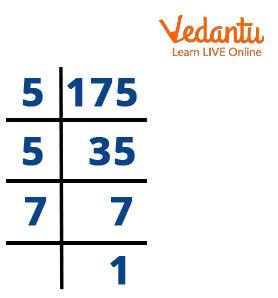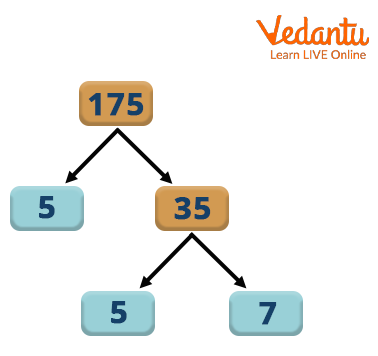




Factor of 175 : An Introduction
A factor is a number that completely divides the original number. Real numbers that can evenly divide the original number are factors of
Let's use straightforward methods in this article to determine the factors, pair factors, and prime factors of
What are the Factors of
The natural numbers that can divide the number
We can determine the other factors of
How to Find Factors of
The natural numbers that can divide the number
In the division method, the factors of
Therefore, the factors of
Prime Factorisation of
Prime factorization is the process of finding the prime terms or prime factors which, when multiplied, give the original number.

Prime Factorization of 175
Take a pair factor of
As the number
Thus,
Write the number
So,
Therefore, the prime factorization of

Factor Tree
Pair Factors of
A factor pair is a pair of numbers that, when multiplied, will result in an original number(or the same product).
To calculate the factor of a number, factors are frequently presented as pairs of numbers. They are referred to as factor pairs. For example- factor pairs of
The pair factors of
Positive Pair Factor of
Therefore, the positive pair factors of
Negative Pair Factor of
Therefore, the negative pair factors of
Prime Factors of
First, note that prime numbers are all positive integers that can only be evenly divided by
All the prime numbers used to divide in the Prime Factor Tree are the Prime Factors of
Again, all the prime numbers you used to divide above are the Prime Factors of
Solved Examples
Example 1: What are the possible factors of
Solution: The natural numbers that can divide a number evenly are factors of
Example 2: Can you assist Aman with adding up all the factors of
Solution: First, we must take out the factors of
Here we can see the
We can conclude here that If you add up all the components of
you get
Example 3: Is
Solution: Yes,
Conclusion
The number
FAQs on The Factor of 175
1. Find the first ten multiples of
We can write as,
Hence,
2. Is the number
We know that a number that may be written as the product of two equal integers is referred to as a perfect square. Knowing that
3. What are the common factors of
A whole number of a factor of two or more numbers is a common factor. To determine the common factors of
Step 1: List the factors of each integer that is given.
Step 2: Identify the shared factors among the given numbers and list them.
1 and 5 are hence the common factors.

























